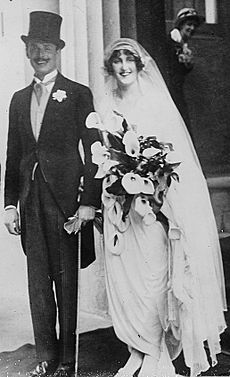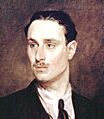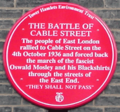Oswald Mosley facts for kids
Quick facts for kids
Oswald Mosley
|
|
|---|---|
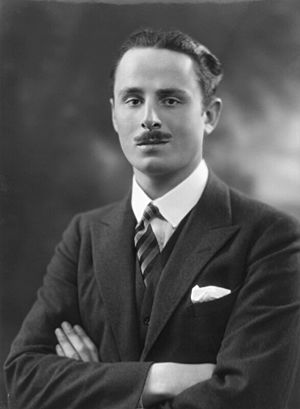
Mosley in 1922
|
|
| Chancellor of the Duchy of Lancaster | |
| In office 7 June 1929 – 19 May 1930 |
|
| Prime Minister | Ramsay MacDonald |
| Preceded by | Ronald McNeill |
| Succeeded by | Clement Attlee |
| Member of Parliament for Smethwick |
|
| In office 21 December 1926 – 7 October 1931 |
|
| Preceded by | John Davison |
| Succeeded by | Roy Wise |
| Member of Parliament for Harrow |
|
| In office 14 December 1918 – 9 October 1924 |
|
| Preceded by | Harry Mallaby-Deeley |
| Succeeded by | Sir Isidore Salmon |
| Personal details | |
| Born |
Oswald Ernald Mosley
16 November 1896 Mayfair, London, England |
| Died | 3 December 1980 (aged 84) Orsay, Essonne, France |
| Political party | British Union of Fascists (1932–1940) |
| Other political affiliations |
Conservative (1918–1922) Independent (1922–1924) Labour (1924–1931) New (1931–1932) Union Movement (1948–1973) National Party of Europe (1962–1980) |
| Spouses | |
| Children | Vivien Mosley (1921–2002) Nicholas Mosley (1923–2017) Michael Mosley (1932–2012) Alexander Mosley (1938–2005) Max Mosley (1940–2021) |
| Education | Winchester College |
| Alma mater | Royal Military College, Sandhurst |
| Occupation | Politician, soldier, farmer |
| Awards | |
| Military service | |
| Allegiance | |
| Branch/service | • 16th The Queen's Lancers • Royal Flying Corps |
| Years of service | 1914–1918 |
| Rank | Lieutenant |
| Battles/wars | First World War • Second Battle of Ypres • Battle of Loos |
Sir Oswald Ernald Mosley (born November 16, 1896 – died December 3, 1980) was a British politician. He was a Member of Parliament in the 1920s. Later, he became known for leading the British Union of Fascists (BUF). This was a political group that believed in fascism, a type of government where one strong leader has total control.
After fighting in the First World War, Mosley became one of the youngest Members of Parliament. He represented Harrow from 1918 to 1924. He started as a Conservative, then became an independent, and later joined the Labour Party. In the 1924 election, he almost beat Neville Chamberlain, who later became Prime Minister.
Mosley returned to Parliament in 1926 as a Labour MP for Smethwick. He served in the Labour government from 1929 to 1931. He was in charge of finding solutions for unemployment. In 1928, he inherited the title of Baronet from his father. He was seen as a possible future Prime Minister. However, he resigned because he disagreed with the government's plans for unemployment. His political group, the New Party, later became the British Union of Fascists in 1932.
Mosley was held in prison in May 1940, and the BUF was banned. He was released in 1943. After the war, he moved abroad in 1951, living mostly in Paris and Ireland. He tried to get back into Parliament later but did not get much support. He also promoted the idea of a united Europe, called Europe a Nation.
Contents
- Oswald Mosley's Early Life and Education
- Military Service in World War I
- Marriages and Family Life
- Political Career in Parliament
- Serving in Government
- Founding the New Party
- Rise of Fascism in Britain
- Internment During World War II
- Post-War Politics and Later Life
- Death and Legacy
- Images for kids
- See also
Oswald Mosley's Early Life and Education
Oswald Mosley was born on November 16, 1896, in Mayfair, London. He was the oldest of three sons. His father was Sir Oswald Mosley, 5th Baronet. His mother was Katharine Maud Edwards-Heathcote.
His family's history goes back to the 12th century. They were important in Staffordshire, England. His great-great-great-great-grandfather became a baronet in 1781. Mosley was also a distant cousin of Queen Elizabeth The Queen Mother.
After his parents separated, Mosley was raised by his mother and his grandfather. His family and close friends called him "Tom." He went to West Downs School and Winchester College.
Mosley was a talented fencing champion in school. He won awards in both foil and sabre fencing. He loved the sport throughout his life.
Military Service in World War I
In January 1914, Mosley joined the Royal Military College, Sandhurst. This is a famous military academy. He was expelled in June for a "riotous act" against another student.
During the First World War, he joined the British cavalry. He fought in France on the Western Front. He later joined the Royal Flying Corps as an observer. While showing off for his mother and sister, he crashed. This accident left him with a permanent limp. It also gave him a reputation for being brave but sometimes reckless.
He returned to the trenches before his injury was fully healed. At the Battle of Loos in 1915, he fainted from pain. He spent the rest of the war working in offices for the Ministry of Munitions and the Foreign Office.
Marriages and Family Life
On May 11, 1920, Oswald Mosley married Lady Cynthia "Cimmie" Curzon. She was the daughter of the 1st Earl Curzon of Kedleston. Her father was a very important politician who had been Viceroy of India.
Their wedding was a grand event at St James's Palace in London. Many important guests attended, including King George V and Queen Mary.
Cynthia died in 1933. After her death, Mosley married his partner, Diana Guinness. They married secretly in Nazi Germany on October 6, 1936. Their wedding took place at the home of Joseph Goebbels, a high-ranking Nazi official. Adolf Hitler was a special guest at their wedding.
Mosley had three children with Cynthia: Vivien, Nicholas, and Michael. He had two more children with Diana: Alexander and Max. His son, Max Mosley, later became president of the Fédération Internationale de l'Automobile (FIA).
Political Career in Parliament
After World War I, Mosley decided to enter politics. He wanted to prevent future wars. He was elected as a Conservative MP for Harrow in 1918. He was only 21 years old.
He quickly became known as a powerful speaker. He often spoke in Parliament without notes. Mosley was one of the youngest members of the House of Commons.
Changing Political Parties
Mosley disagreed with the Conservative Party's policies on Ireland. He spoke out against the actions of the "Black and Tans" against civilians during the Irish War of Independence.
In late 1920, he left the Conservative Party. He became an independent MP. He kept his seat in the 1922 and 1923 elections.
By 1924, he was drawn to the Labour Party. He joined them in March. He also joined the Independent Labour Party (ILP).
When the Labour government fell in October 1924, Mosley ran for a new seat. He challenged Neville Chamberlain in Birmingham Ladywood. Mosley campaigned very strongly. He lost by only 77 votes. He blamed bad weather for the close result.
Mosley returned to Parliament in 1926. He won the by-election for Smethwick. In 1927, he made fun of the "British Fascists," calling them "black-shirted buffoons."
Serving in Government
Chancellor of the Duchy of Lancaster
Mosley wanted to advance in the Labour Party. He was close to Prime Minister Ramsay MacDonald. In 1929, when Labour won the election, Mosley was given the job of Chancellor of the Duchy of Lancaster. This was a position without a specific department, outside the main Cabinet.
He was given the task of solving the problem of unemployment. However, his new ideas were often blocked by other ministers or the Cabinet.
The Mosley Memorandum
Mosley saw that Britain's economy was struggling. He wrote a plan called the "Mosley Memorandum." It suggested high taxes on imported goods to protect British industries. It also proposed that the government take control of major industries. He wanted to raise the school-leaving age and pensions to reduce the number of people looking for jobs. He also suggested a plan for public works projects to create jobs and reduce poverty.
This plan aimed to combine businesses, workers, and the government. Mosley believed this would end class conflict and make the British economy strong again. He published this plan because he felt both Labour and Conservative parties were not doing enough.
However, the Cabinet and the Labour Party rejected his ideas. In May 1930, Mosley resigned from his government job. The economist John Maynard Keynes supported Mosley's plan, calling it "a very able document."
Founding the New Party
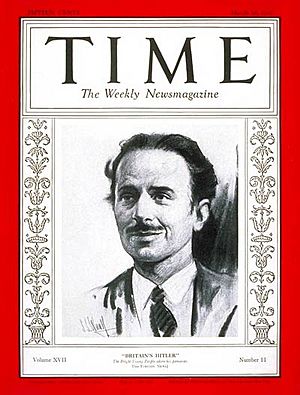
Mosley was unhappy with the Labour Party. He and six other Labour MPs started the New Party.
This new party gained some support. Many Labour and Conservative politicians agreed with his economic ideas. The Daily Mail newspaper also supported the New Party for a short time.
The New Party started to lean more towards authoritarian ideas. Many of its early supporters left. In the 1931 General Election, the party's candidates, including Mosley, lost their elections.
Rise of Fascism in Britain

After his election loss in 1931, Mosley traveled to Italy. He studied the "new movements" there, especially Fascist Italy under Benito Mussolini. He became convinced that fascism was the right path for Britain.
In 1932, he created the British Union of Fascists (BUF). The BUF wanted to protect British industries and was strongly against communism. It was also very nationalistic, meaning it believed Britain was superior to other nations. Mosley claimed the BUF aimed for "national socialism."
The BUF claimed to have as many as 50,000 members. It briefly had support from newspapers like the Daily Mail. Mosley was described as "strikingly handsome" and "probably the best orator in England."
Mosley created a group of uniformed stewards called "Blackshirts." They were like the Italian fascist Blackshirts. The BUF often had violent clashes with opposing groups, especially in London. At a large rally in June 1934, the violence caused bad publicity for the BUF. This led to the loss of much of their public support.
Mosley continued to promote anti-Semitism, which is prejudice against Jewish people. In 1935, he openly challenged "Jewish interests" in the country. The party could not run in the 1935 general election.
In October 1936, Mosley and the BUF tried to march through an area of London with many Jewish residents. This led to violence, known as the Battle of Cable Street. Protesters tried to block the march, and police tried to force it through. Eventually, the police commissioner stopped the march.
The government became worried about the BUF. They passed the Public Order Act 1936. This law banned political uniforms and military-style groups. It came into effect in 1937.
As Europe moved towards war, Mosley campaigned for Britain to stay out of it. His rally in July 1939 was the largest indoor political rally in British history. It had about 30,000 attendees.
Internment During World War II
In May 1940, Mosley was arrested and held in prison. This happened shortly after Winston Churchill became Prime Minister. The government believed Mosley was too dangerous during wartime. He was held under a special law called Defence Regulation 18B. He was never formally charged with a crime.
Most other active fascists in Britain were also held. This effectively removed the BUF from British politics. Mosley's wife, Diana, was also held in prison. They lived together for most of the war in a house on the grounds of Holloway prison. The BUF was officially banned later that year.
Mosley used his time in prison to read many books about politics and history. He refused visits from most BUF members. In November 1943, the government ordered the release of the Mosleys. After a big debate in Parliament, the decision was supported. Mosley, who was ill, spent the rest of the war under house arrest and police supervision.
Post-War Politics and Later Life
After World War II, former supporters asked Mosley to return to politics. In 1948, he formed the Union Movement. This group called for a single nation-state to cover all of Europe, known as Europe a Nation. In 1962, he tried to start a National Party of Europe. He was described as a "Europhile," meaning someone who loves Europe.
The Union Movement's meetings were often disrupted by protests. In 1951, Mosley decided to leave Britain and live in Ireland. He said it was easier to work from outside the country. In the 1950s, Mosley suggested dividing Africa into black and white areas.
Mosley also became a key figure in Holocaust denial. He claimed that Nazi concentration camps were necessary to hold "disaffected people." He said problems there were caused by lack of supplies and disease, not by the Nazis trying to kill people. He tried to discredit photos from camps like Buchenwald. He also claimed that the Holocaust was the fault of Jewish people and that Adolf Hitler knew nothing about it.
After the 1958 Notting Hill race riots, Mosley briefly returned to Britain. He ran in the 1959 election in Kensington North. He campaigned against immigration. He called for immigrants from the Caribbean to be sent back home. He also wanted to ban mixed marriages. He received 8.1% of the vote.
Soon after, Mosley moved permanently to Orsay, near Paris. He returned to politics one last time in the 1966 election. He received 4.6% of the vote. After this, he retired and moved back to France. He wrote his autobiography, My Life, in 1968.
In 1977, Mosley was suffering from Parkinson's disease. He was nominated for Rector of the University of Glasgow. He received over 100 votes but finished last.
Mosley's ideas are thought to have influenced the organic farming movement in Britain. Some early members of the Soil Association, which promotes organic farming, were connected to Mosley's ideas.
Death and Legacy
Oswald Mosley died on December 3, 1980, in Orsay, France. His body was cremated, and his ashes were scattered on a pond there. His son Alexander said they received many messages of sympathy.
Mosley's personal papers are kept at the University of Birmingham's Special Collections Archive.
Mosley and his first wife, Cynthia, lived at Savay Farm. After his release from prison, he lived with his second wife, Diana, at Crux Easton. In 1945, he moved to Crowood Farm, which he managed.
Mosley's home in Ireland, Ileclash House, was put up for sale several times. He bought and restored it in the 1950s. He also bought and restored Clonfert Palace in Ireland during the same decade.
Images for kids
-
Mosley on the cover of Time in 1931
-
Italy's Duce Benito Mussolini (left) with Oswald Mosley (right) during Mosley's visit to Italy in 1936
See also
 In Spanish: Oswald Mosley para niños
In Spanish: Oswald Mosley para niños
- The European
- Houston Stewart Chamberlain



